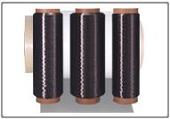 AEC Carbone fiber reinforcement system*more about products* |
|
Speciality of material |
|
Strengthening of carbon fiber which was created by the US and Japan is applicable for civil engineering recently. It is well applicable for strengthening of columns. Strength of encirclement which is caused by viscidity will strengthen toughness of columns to reinforce the ability earthquake-resistant and compress-resistant. |
|
| 1.High performance | |
Strength of carbon fiber is always higher than of steel. Even strength of some is quadruple of strength of steel. |
|
| 2.To reinforce the toughness of section | |
Carbon fiber is high-strength material. It is fit for current standard of earthquake-resistant because of its high strength of encirclement which will reinforce toughness of construction when it is applied to strengthen column. |
|
| 3.Light weight | |
Carbon fiber is lighter than aluminium. Earthquake force caused by carbon fiber is enough low for its light weight. So, carbon fiber is a very good material for reinforcement. |
|
| 4.Not to change the shape of column before | |
Carbon fiber doesn’t change the shape of column before when they are reinforced, even the shape of square, rectangle, hexagon and others. |
|
| 5.To hardly be influenced by space | |
Carbon fiber work well in small space even only 10cm-high space |
|
| 6.Good permanence and corrosive resistant | |
Carbon fiber have good resistance capability to salt, soil and corrosive condition. |
|
How to use |
|
| Step by step: | |
| 1.Surface treatment | |
|
|
| 2.Repair of section | |
|
|
| 3.To make surface flat | |
|
|
| 4.Brushing with primer | |
Don't operate when rain or dew possibly or temperature below 5℃. To use appropriate epoxy resin after temperature and humidity are confirmed.
|
|
| 5.To affix with unilateral carbon fiber | |
Don't operate when rain or dew possibly or temperature below 5℃. To use appropriate epoxy resin after temperature and humidity are confirmed.
|
|
| 6.Maintaining | |
When work out of door, use plastic film to protect from rain, sand, dust etc.
When average temperature is 20℃, maintaining time is not less than one week. |
|
| 7.Protection of surface | |
|
|
|
|||
| 1.About temperature | |||
Viscidity of primer and epoxy will be up when cool. So, rigidification will become slow and don't rigidify completely. Don't operate below 5℃. |
|||
| 2.About humidity | |||
Water is harmful to attaching of the primer and epoxy resin. To make water- stopping treatment if some cracks leak. Don't operate when dew possibly. |
|||
| 3.Surface treatment | |||
To cut away the plumpness of surface and fill up the sunken with epoxy resin or resin-slurry. The radius of plump corners is not less than 10mm with 1mm’ max-error. |
|||
| 4.Use of primer and epoxy resin | |||
To adjust viscidity by temperature up, and don't dilute it with organic reagent. To mix reagent and hardener appropriately, and don't use it if it is overtime. |
|||
| 5.About CFRP | |||
Don't fold CFRP patch at random. To leave 10cm-length along the direction of unilateral fiber to connect with the next when to attach, and needn't do it along the other direction. |
|||
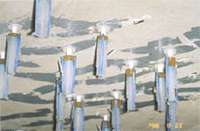
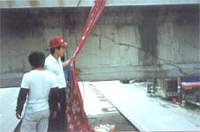
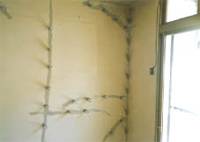
| Country | Presenter | The maximal crack width allowed (mm) | |
| Japan | Ministry of Communication Industry code of Japan |
Construction near bay | |
| RC tube under centrifugal force | 0.25 | ||
| Members under advised moment | 0.05 | ||
| After releasing advised load and moment | |||
| France | Brcard | 0.4 | |
| Sweden | Roads and bridges only under basic load | 0.3 | |
| Basic load plus half of live load | 0.4 | ||
| US | ACI | Members indoor Members outdoor | 0.38 |
| Russia | Concrete code | 0.2 | |
| Europe | UCI | Members under corrosiveness | 0.1 |
| General members no protected | 0.2 | ||
| General members protected | 0.3 | ||
|
Environment of construction |
The maximal crack width allowed (mm) |
|||
|
In dry air or covered by protection surface |
0.40 |
|||
|
In wet air and soil |
0.3 |
|||
|
When touching reagent of coolant-resistant |
0.175 |
|||
|
In wet and dry environment which acted again and again by seawater and sea breeze |
0.15 |
|||
|
Member made by water-resistant material |
0.10 |
|||
|
|
[CEB.FIP international code] |
|||
|
Environment |
Support dead load and long term load synchronously |
Support dead load and adverse load synchronously |
||
|
Members exposed to harmful environment |
0.3 |
0.2 |
||
|
Members protected |
0.2 |
0.3 |
||
|
Members no protected |
0.3 |
According to aspect requirement |
||
|
Density |
|
|
1.4kg/L |
|
|
Operated
time |
|
General
(N) |
Fast
Dry (F) |
|
|
|
20℃ |
120min |
30min |
|
|
|
30℃ |
40min |
15min |
|
|
Compressive
strength |
|
General
(N) |
Fast
dry (F) |
|
|
|
8h |
40
N/mm2 |
50
N/mm2 |
ASTM
C348-92 |
|
|
16h |
50
N/mm2 |
55
N/mm2 |
ASTM
C348-92 |
|
|
7days |
60
N/mm2 |
60
N/mm2 |
ASTM
C348-92 |
|
Tensile
strength |
|
|
10
N/mm2 |
ASTM
C190-85 |
|
Bend
strength |
|
|
15
N/mm2 |
ASTM
C109-92 |
|
Shear
strength |
|
|
10
N/mm2 |
ASTM
D1002-72 |
| Density |
1~1.1kg/L |
|
|
| Operated time |
20℃ |
120min |
|
| Viscidity |
20℃ |
400~500cps |
|
| Compressive strength |
7
days later |
60 N/mm2 |
ASTM C348-92 |
| Tensile strength |
7
days later |
20 N/mm2 |
ASTM C190-85 |
| Bend strength |
7
days later |
40 N/mm2 |
ASTM C109-92 |
| Shear strength |
7
days later |
12 N/mm2 |
ASTM D1002-72 |
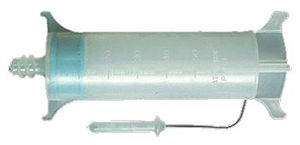
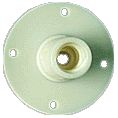
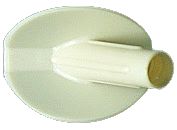
|
Aspect
|
Gray super mote
|
Fluidity
|
Water-cement ratio: 0.4
Fluidity data: 300mm |
|
Specific gravity
|
3.0±0.1
|
Curing value
|
About 4h(according to water-cement ratio and temperature) |
|
Thin degree
|
8000cm2/g(Blaine)
|
Compressive strength
|
6500psi(28days) |
|
Items |
Unit |
Test value |
Test method |
|
|
Fluidity value |
mm |
>230 |
ASTM C230 |
|
|
Expandability |
% |
0.01~0.02 |
ASTM C878 |
|
|
Water penetrability |
% |
0 |
ASTM C243 |
|
|
Compressive strength |
7days |
N/mm2 |
>50 |
ASTM C109 |
|
28 days |
>60 |
|||
|
Bend strength |
7days |
N/mm2 |
>10 |
ASTM C347 |
|
28days |
>12 |
|||
|
Grasp strength |
7days |
N/mm2 |
>8 |
ASTM C234 |
|
28days |
>9 |
|||
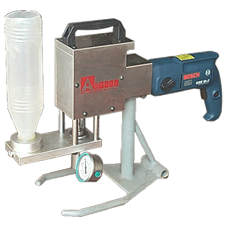

| Items | Component | Applications |
| AS155 | Single vesicant PU |
|
| AS156 | Dual vesicant PU |
|
| AS157 | Dual non-vesicant PU |
|
| AS158 | Dual rigidity PU |
|
|
AS155 |
Single vesicant PU |
|
Density (23℃) |
1.1g/cm3 |
|
Viscidity (23℃) |
250~350mPas |
|
Gravity ratio to water after mixture |
AS155:water=40:1 |
|
Density after hardening (23℃) |
0.1±0.02g/cm3 |
|
Expansion ratio |
10~20times |
|
Act time(mixed with 2%water) |
20~40s |
|
Start to act |
80~90s |
|
Development time |
3~4min |
|
Hardening time |
20s |
|
AS156 |
Dual vesicant PU |
|
Density(23℃) |
1.1g/cm3 |
|
Viscidity(23℃) |
260~370mPas |
|
A and B ratio by mixed |
A:B=10:1 |
|
Density after hardening |
0.1±0.01g/cm3 |
|
Expansion ratio |
15~25times |
|
Act time(mixed with 10%water) |
10~20s |
|
Start to act |
5~15s |
|
Development time |
1~2min |
|
Hardening time |
5min |
|
AS157 |
A glue |
B glue |
|
Density |
1.03 |
1.09 |
|
Viscidity |
500~600 |
100~400 |
|
Gravity ratio |
2 |
1 |
|
Fire point(℃) |
140 |
176 |
|
Rigidity |
20~30 |
|
|
Extensibility (%) |
>150 |
|
|
Tensile strength (MPa) |
≧26 |
|
|
Adhibition strength (MPa) |
>26 |
|
|
Contract degree (%) |
<0.05 |
|
|
Expansion ratio |
1.08 |
|
|
Hardening time |
24h |
|
AS158 |
A glue |
B glue |
|
Density |
1.1 |
1.01 |
|
Viscidity |
250~300 |
300~400 |
|
Gravity ratio |
1 |
1 |
|
Fire point(℃) |
140 |
176 |
|
Rigidity |
80 |
|
|
Extensibility (%) |
>103 |
|
|
Tensile strength (MPa) |
26 |
|
|
Adhibition strength (MPa) |
>26 |
|
|
Compressive strength(MPa) |
38 |
|
|
Contract degree (%) |
<0.05 |
|
|
Hardening time |
24h |
|
Remains by heated |
>=93% |
ASTM D2369 |
|
Tensile strength |
>=20kg/cm2 |
ASTM D412 |
|
Extensibility |
>=800% |
ASTM D412 |
|
Recover ability |
>=50% |
ASTM D412 |
|
50%M |
3~3.5kg/cm2 |
JIS 5758 |
|
150%M |
4.5~5kg/cm2 |
JIS 5758 |
|
AE150 |
AS2000 |
V-cut |
|||||||||
|
Building
of concrete |
AE160 |
AC810 |
AC100 |
AE160 |
AC810 |
AS155 |
AS156 |
AS157 |
AS158 |
AE111 |
AF806 |
|
Common
condition |
|||||||||||
|
main |
★★★★ |
★★ |
- |
★★★ |
★★ |
- |
- |
- |
★★★ |
★ |
- |
|
minor |
★★★ |
★★★★ |
★ |
★★★ |
★★★ |
- |
- |
- |
★★★ |
★ |
- |
|
main |
★★ |
★★★★ |
★★ |
★★ |
★★★ |
- |
- |
- |
★★★ |
★★ |
- |
|
Minor |
★ |
★★★★ |
★★★ |
- |
★★★★ |
- |
- |
- |
★★★ |
★★ |
- |
|
window |
★★★ |
★★★ |
- |
- |
- |
★★ |
★★ |
★★★ |
★★ |
★★ |
★★★ |
|
work |
★★★ |
★★★ |
★ |
- |
- |
★★ |
★★ |
★★★ |
★★★ |
★★★ |
★★ |
|
separation |
★★ |
★★★ |
★★★ |
- |
- |
★★★ |
★★★ |
★★★ |
★★★★ |
★★★ |
★ |
|
Heavy
wet or leakage |
|||||||||||
|
t≦3mm |
- |
★★★★ |
★ |
- |
★★★ |
★★ |
★★ |
★★ |
★★★★ |
- |
- |
|
t<3mm |
- |
★★★ |
★★★★ |
- |
★★★★ |
★★★ |
★★★ |
★★ |
★★★★ |
- |
- |
|
window |
- |
★★★ |
- |
- |
- |
★★★ |
★★★ |
★★★★ |
★★ |
- |
- |
|
work |
- |
★★★ |
★★ |
- |
- |
★★★ |
★★★ |
★★★★ |
★★★ |
- |
- |
|
separation |
- |
★★★ |
★★★ |
- |
- |
★★★ |
★★★ |
★★★ |
★★★★ |
-- |
- |
|
heavy
water flow |
- |
- |
- |
- |
- |
arrange in pairs or groups |
- |
- |
|||
|
Building
of brick porous concrete |
|||||||||||
|
dry
|
★ |
★★★ |
★★★ |
- |
- |
★★★ |
★★★ |
★★★ |
★★★ |
★★★ |
★★★ |
|
wet
|
- |
★★★ |
★★★ |
- |
- |
★★★ |
★★★ |
★★★ |
★★★ |
- |
- |
|
cracks
of brush layer |
- |
- |
- |
- |
- |
- |
- |
- |
- |
★★★ |
★★★ |
|
common
light partition |
- |
- |
- |
- |
- |
- |
- |
- |
- |
★★ |
★★★★ |
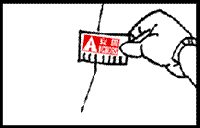
|
Carefully measure crack’ width, length and shape,confirm operation step and material used. |
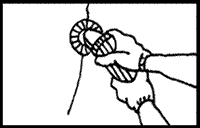
|
Use steel wire brush or grinding wheel machine etc. to rubdown the surface that will be painted with sealant, and make stiff surface be exposed. |
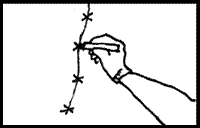
|
Confirm injecting point, the distance between two cracks is about 25~30cm(almost as same as cracks’ depth) |
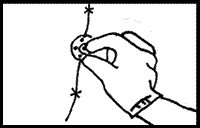
|
Install bases for injecting with sealant AE111, and the center of bases tallies with the center of cracks |
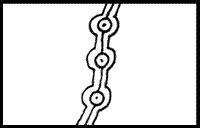
|
Seal the surface of cracks with sealant AE111 to protect resin from leaking(make a sealed belt that width is 30mm and thickness is 1~2mm) |
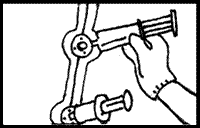
|
After sealant hardened, inject resin into cracks by AE150 continual pressure injecting method and injecting should be done from low point to high Point. |
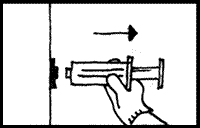
|
Remove injectors after resin has hardened |
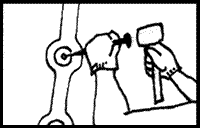
|
Knock down bases, and use grinding wheel machine to rubdown the surface and paint them with decorated material. |
|
Section figure of hi-pressure injecting to work cracks
|
|
Cut plane figure of hi-pressure injecting to work cracks
|
| Notice: to drill holes with 1/2 thickness of structure |
|
Section figure of hi-pressure injecting to structure cracks
|
|
Cut plane figure of hi-pressure injecting to structure cracks
|
|
Section figure of hi-pressure injecting to honeycomb
|
|
Cut plane figure of hi-pressure injecting to honeycomb
|
|
Stop water figure for cracks of window frame (underside)
|
|
Stop water figure for cracks of window frame (whole)
|
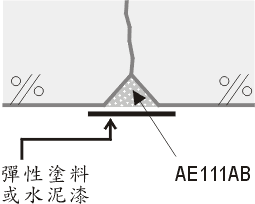
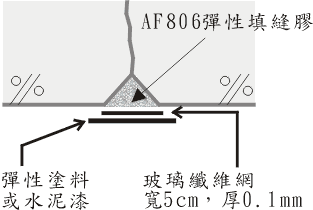
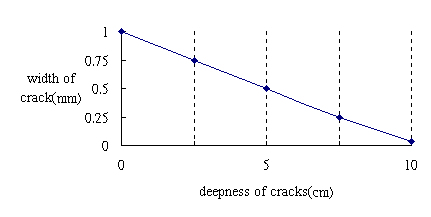
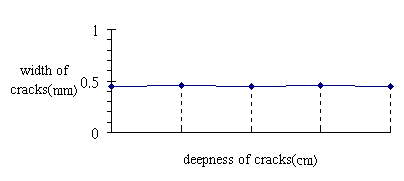
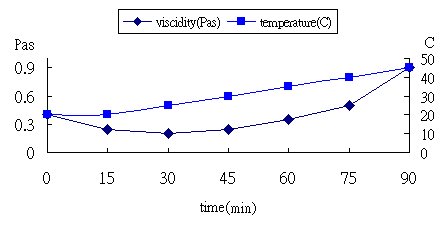
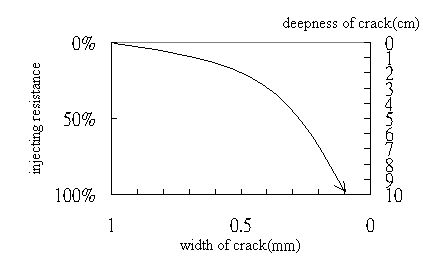
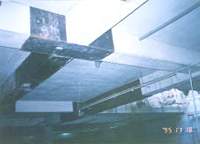
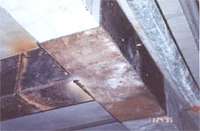
|
|
|||
1.Figures of beam reinforcement 
 B-B B-B
 A-A A-A
Usage advice about chemical anchor:
2.Figures of column reinforcement

A-A
|
|||
| Preface | |||
|
RC construction must be reinforced to make it safe when they become danger because of fire, damage of material and load alter etc. Methods of reinforcement include altering construction system and reinforcing strength of construction component, such as beams and columns.
On altering construction system, methods of adding walls, declining shore, and columns alter load system as a whole. Thus, construction system load is shared to make old construction reinforced.
On reinforcing strength of construction component, reinforcement of steel plates (or FRP etc.) is a method in common use. Commonly, altering construction system is a economical, effectual method if the method don't change function of old construction. However, the method can generally damage function of old construction. Thus, the method is difficult to use effectually.
The method, reinforcing strength of construction component, is not economical, but it is a popular method when we consider benefit as a whole (function is more important than reinforcement cost).
The reinforcement method of construction component includes steel plates (or FRP) reinforcement and enlarging section and bar of members. When we use the method of enlarging section and bar of members, we should consider the ways of operation of interface between new and old concrete and bar's joint and fixation. The effect of operation can be evaluated by current RC theory. So, we can gain our ends for construction reinforcement.
However, enlarging section of members will reduce active space. It is difficult to accept the method because it is so expensive to buy a block of land or house in modern city. Thus, the method of steel plates (or FRP) reinforcement is more popular than that.
When we reinforce RC construction with steel plates, we should affix steel plates on two sides of beams with epoxy resin and anchor them at appropriate point with bolts to form sandwich beams. The bend theory of the sandwich beams display that the method of affixing steel plates on two sides of beams can reinforce moment and shear of old RC beams.
According to theory above and experimental result, this paper present a simple and effectual design table and design method to be adopted by construction engineers when they make some designs for reinforcement of RC beams.
|
|||
|
|||
|
|
|
|
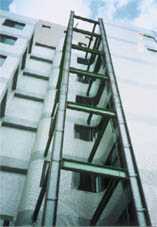
Reinforcement with H-profiled steel when usages of building change or more structure strength need. |
|
|
§ Steps on adding H-profiled bar to reinforce
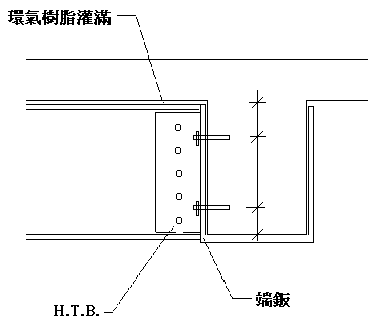
|
|
|
||
|
||
| Installations | ||
|
||
|
|
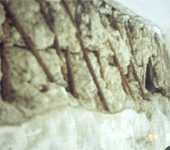
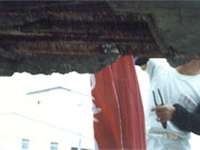
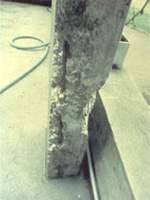
Different methods to repair sea-sand house |
|
|
||||||||||||||||||||
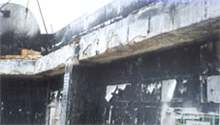
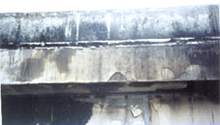
Construction of structure repair and reinforcement after fire |
||||||||||||||||||||
| Reinforcement of board | ||||||||||||||||||||
|
||||||||||||||||||||
§Figure of the method of cracks repair (A)AE160 injection for cracks (RC member, width of cracks > 0.2mm)
(B) Cut v shape grooves and fill them with epoxy (be fit for brick wall)
(C) Cut v shape grooves and fill them with elastic glue (be fit for light brick wall or cracks between two different material)
(D) Brush and seal surface of elastic dope (be fit for brushing cracks)
PS. Cracks should be reinforced with fiber net in this method in terms of actual situation, and use them in turn according to spot and cracks. |
||||||||||||||||||||
| Reinforcement of beams because tubes cross them or flexibility change | ||||||||||||||||||||
Steps of steel plates reinforcement of RC beams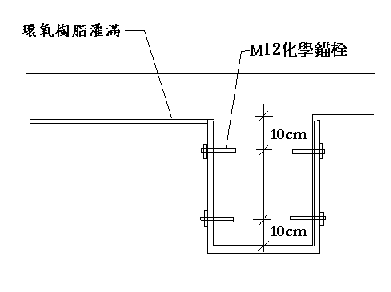 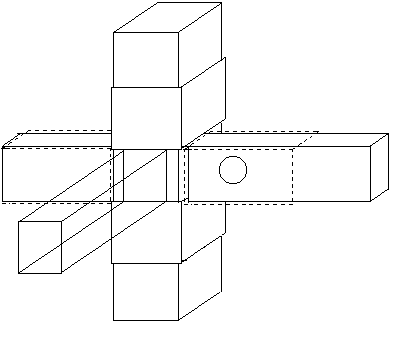 |
||||||||||||||||||||
|
|
||||||||||||||||||||
|
||||||||||||||||||||
|
|
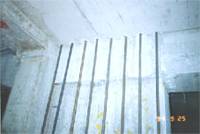 |
|
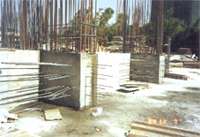 |